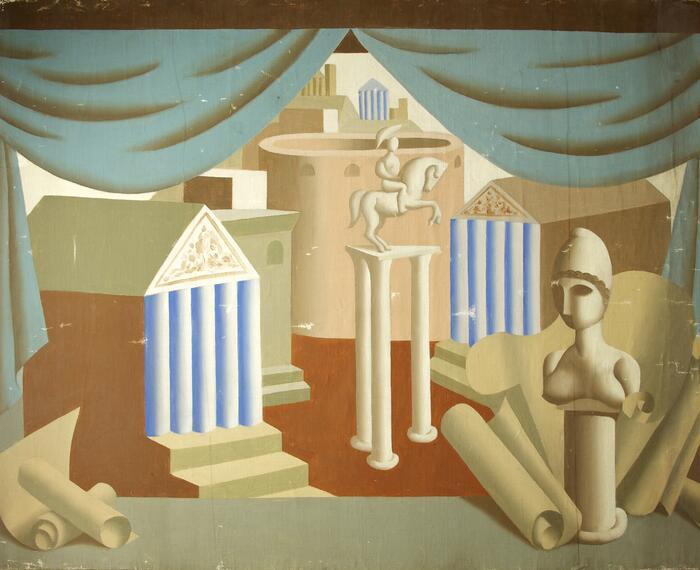


Isaac Julien, 'O que é um museu? / What is a Museum?' (Lina Bo Bardi – A Marvellous Entanglement), 2019. © Isaac Julien. Courtesy the artist and Victoria Miro, London/Venice
The debut of a new film installation by Isaac Julien is an event, and this new nine-screen work showing in the upper floor of the Wharf Road gallery has been six years in the making. Some of you may recall the work Stones against Diamonds, 2014 that took it’s title from a letter of Lina Bo Bardi’s, in which she extolled the virtues of semi-precious stones over precious ones. That moment marks the beginning of Julien’s fascination with Brazil’s great female modernist architect.
The Ladeira da Misericórdia is the name of the steep slope that leads from the port of Salvador in Brazil, up to the historic colonial centre of Pelourinho. It is so named because this was the route used to bring cargo up to the city, carried on the backs of African slaves – it translates as the ‘slope of pity’. Salvador de Bahia was Brazil’s main slave port from the seventeenth to the late nineteenth century, with the Portuguese colonial rulers bringing men and women in vast numbers from Angola and the Gold Coast. As a consequence of this trade, the city and the region in general is characterised by profound African influences, from the Afro-Brazilian religious cults of candomblé and macumba, to the unique music and dance culture.
In the late 1980s, the Italian born architect, Lina Bo Bardi was invited to build a social housing and commercial complex on the Ladeira da Misericordia. The building, Coaty, is an expression of her radical architectural approach that viewed architecture as “total-space”, an active participant in human life, and the individual as an “actor” in the space of the world. While much loved by the local population, the complex was soon shut down and remains empty to this day. It is a testament to Isaac Julien’s dedication to the legacy of Bo Bardi that he managed to gain access to Coaty to film for his magisterial new work, and homage to the great modernist architect of Brazil.
“Linear time is a western invention; time is not linear, it is a marvellous entanglement, where at any moment points can be chosen and solutions invented without beginning or end.”
The architect’s words recur throughout the 45 minutes of the film installation. She is represented by two actresses, simultaneously playing her younger and older selves. The third character invoked by the work is the photographer and ethnographer Pierre Verger, who arrived in Salvador in 1946 and made it his life’s work to document the Yoruba culture of the West African diaspora there. Verger and Bo Bardi collaborated on the design of Coaty on the Ladeira da Misericordia and on the Casa do Benin, also in Salvador.
Verger’s 1978 visit to Brazil is recalled in black and white archive photographs that punctuate film sequences that move through some of Bo Bardi’s most famous buildings. The wooden staircase of the Museu de Arte Moderno da Bahia is a marvel. Constructed using vernacular techniques more associated with simple ox-carts, it is a syncopated wooden helix that rises without handrail through the floor of the building. We watch a cleaner sweeping gracefully backwards down the stairs, and then a whirling dancer, from the Balé Folclórico da Bahia dance company, enters in a flying red gown mimicking the spiralling architecture.
Simplicity with sophistication, an absolute honesty in relation to materials – these are among the principles that guided Bo Bardi. The architect’s words accompany the camera as it explores even more dramatic projects such as the SESC Pompéia and Museu de Arte de São Paulo (MASP), with their giddying aerial walkways and dramatic red-painted balustrades. Windows should be without glass, to allow for natural ventilation, we are told. Rooms should never have carpet, and the seats of a theatre should be like those in a Roman amphitheatre: un-cushioned, as befits entertainment for the masses, not just the cosseted upper classes.
It would be difficult to remain seated at all to view this work – it requires one to swivel and turn from one screen to the next, so that the effect is of a total immersion in a single aesthetic realm. Julien has borrowed the form of Bo Bardi’s ‘easels’ from the MASP as supports for some of his screens, in a further layer of homage, and downstairs one of the large photographic works is hung against a brilliant blue curtained wall, picking out another of her design signatures.
A hymn from one artist to another, across generations, continents and artforms, A Marvellous Entanglement also encompasses the historic Atlantic slave trade and the experience of diaspora within its multi-faceted scope. Allow 45 minutes to see the work in its entirety and considerably more to meditate on its many resonances.
Caroline Douglas
Director
Victoria Miro Gallery, 16 Wharf Road, London N1 7RW. Open Tuesday-Saturday 10.00-18.00. Exhibition continues until 27 July 2019. www.victoria-miro.com